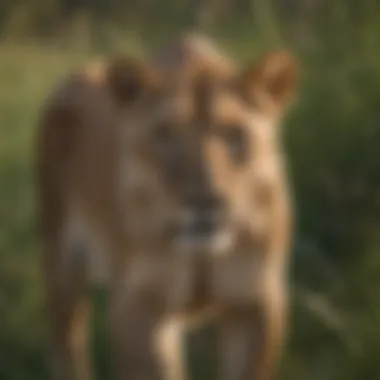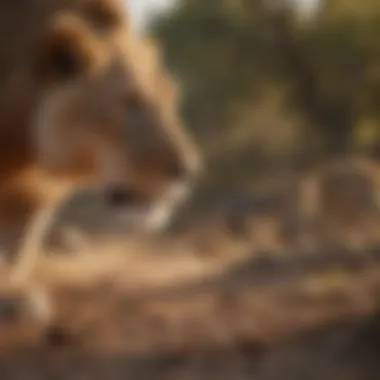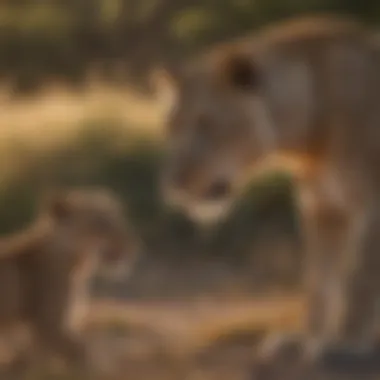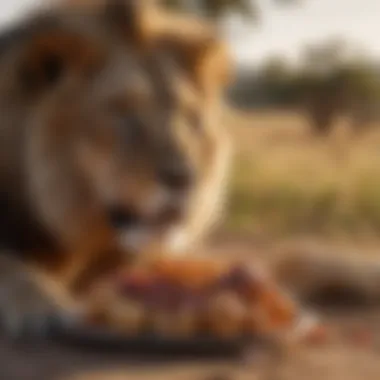Unveiling the Enigmatic Feeding Habits of Lions: A Dive into Predatory Behaviors


Animal Species Profile
Unraveling the complex ecosystem of lion feeding habits is a farsighted endeavor that unveils the multifaceted nature of these majestic predators. Lions, scientifically known as Panthera leo, stand as a symbol of regality in the vast landscapes of Africa's savannahs. Their physical characteristics are characterized by magnificent golden hues, powerful musculature, and distinctive roars that echo through the plains. In the realms of their sprawling natural habitat, the lions command authority as top predators, inhabiting the grasslands, woodlands, and semi-arid regions with remarkable adaptability. Behaviourally, lions exhibit intricate social interactions marked by cohesive pride structures, hierarchical dynamics, and cooperative hunting strategies.
Conservation & Wildlife Efforts
Considering the conservation status of lions is crucial in understanding the extensive efforts required to safeguard these iconic species. Threats loom over lions, stemming from habitat loss, human-wildlife conflict, poaching, and illegal trade. Various conservation initiatives led by organizations such as the World Wildlife Fund and Panthera focus on mitigating these threats through habitat protection, community engagement, and anti-poaching measures. Noteworthy success stories in lion conservation efforts include the recovery of lion populations in some regions, demonstrating the positive impact of dedicated wildlife conservation work.
Animal Behavior & Psychology
Delving into the intricate realm of lion behavior and psychology unveils a tapestry of communicative cues, reproductive strategies, and cognitive abilities. Lions communicate through a diverse range of vocalizations, body postures, and scent markings, essential for maintaining social bonds within the pride. Reproductive behavior showcases the matriarchal structure within lion prides, where lionesses play a vital role in hunting and caring for offspring. Lions exhibit notable cognitive prowess, showcased through problem-solving skills during hunting pursuits and social interactions that highlight emotional intelligence within the pride.
Unique Facts & Trivia
Exploring the lesser-known facets of lions reveals a trove of unique facts and intriguing adaptations that propel them into the realm of enigmatic creatures. Lions possess retractable claws, an adaptation aiding in catching prey and maintaining grip during hunts. Surprising behaviors such as communal nursing of cubs by multiple lionesses and synchronized hunting techniques further distinguish lions as fascinating beings. Additionally, their record-breaking feats include being the only truly social cat species, displaying unparalleled teamwork and cohesion within the pride structure.
Introduction to Lion Feeding Habits
In this section, we embark on an enlightening journey into the enigmatic feeding habits of lions. Understanding the nuances of how these majestic predators feed is crucial in appreciating their place in the ecosystem. Lions, as apex carnivores, play a vital role in maintaining the delicate balance of nature. By delving into their feeding habits, we gain insights into their behavior, adaptations, and survival strategies.
Overview of Lion Dietary Needs
Carnivorous Nature of Lions
Delving into the carnivorous nature of lions reveals fascinating insights into their dietary preferences and biological adaptations. Lions are obligate carnivores, meaning their diet primarily consists of meat. This dietary specialization is a result of their evolution as top predators in the savannas of Africa. The carnivorous nature of lions is characterized by sharp, carnivorous~ teeth adapted for tearing flesh and claws optimized for hunting. This specialization in meat consumption equips lions with the energy and nutrients needed for their active lifestyle in the wild.


Nutritional Requirements
Exploring the nutritional requirements of lions unveils the intricacies of meeting their dietary needs in the wild. Lions have specific nutritional demands to support their growth, reproduction, and overall health. Their diet must provide essential nutrients such as protein, fats, vitamins, and minerals in appropriate proportions. Meeting these nutritional requirements is crucial for the fitness and success of individual lions, as well as the stability of the pride as a whole. Understanding the nutritional requirements of lions offers valuable insights into their foraging behaviors and dietary choices.
Importance of Understanding Lion Feeding Behavior
Ecological Impact
Examining the ecological impact of lion feeding behavior sheds light on the ripple effects of their dietary choices in the ecosystem. Lions, as apex predators, influence the population dynamics of prey species, helping regulate their numbers to prevent overgrazing or overpopulation. By understanding how lions impact their environment through feeding, conservationists and researchers can develop effective management strategies for maintaining biodiversity and ecological balance.
Conservation Implications
Exploring the conservation implications of lion feeding behavior reveals the interconnected nature of wildlife management and habitat conservation. The way lions feed and interact with their environment directly affects their survival and the health of the ecosystem. Conservation efforts aimed at protecting lions must take their feeding habits into account, ensuring sustainable practices that support both lion populations and their habitats. By comprehensively understanding the conservation implications of lion feeding behavior, stakeholders can make informed decisions to safeguard these iconic predators for future generations.
Feeding Behavior of Lions in the Wild
Feeding behavior of lions in the wild is a topic of paramount importance in this article as it sheds light on the intricacies of how these majestic predators survive and thrive in their natural habitat. Understanding the feeding behavior of lions in the wild unveils a world of strategic choices, survival mechanisms, and ecological balances. By delving into the specifics of how lions feed in their natural environment, we gain invaluable insights into their hunting strategies, feeding patterns, and the challenges they face. This section aims to dissect the nuances of lion feeding behavior and explore the key elements that drive their survival.
Hunting Strategies of Lions
Group Hunting Techniques
Group hunting techniques employed by lions are a defining aspect of their feeding behavior. Lions often hunt in groups to increase their chances of success and optimize their prey capture efficiency. Collaborative efforts in hunting enable lions to tackle larger prey, improve their strategic coordination, and ensure better resource allocation within the pride. Within this article, exploring the dynamics of group hunting techniques provides a window into the social structures and cooperative nature of lion prides. Despite the advantages group hunting offers, it also comes with inherent risks such as increased competition among pride members and potential conflicts during feeding.
Individual Hunting Methods


In contrast to group hunting, individual hunting methods showcase the self-sufficiency and adaptability of lions in their pursuit of prey. Individual hunting methods allow certain lions, especially solitary males or lionesses outside the pride, to target smaller prey or be more agile in their hunting approach. The unique feature of individual hunting lies in the flexibility and opportunistic nature it affords to lions. While group hunting may ensure higher success rates and shared resources, individual hunting methods provide lions with independence and the ability to exploit diverse prey opportunities. However, this strategy also requires heightened stealth and agility from the solitary hunter to secure a successful kill.
Role of Lionesses in Hunting
Collaborative Hunting Patterns
The role of lionesses in hunting is a critical component of the pride's success in securing prey. Collaborative hunting patterns among lionesses involve synchronized moves, strategic positioning, and efficient communication to outmaneuver fast-moving prey and optimize hunting strategies. In this article, delving into the collaborative hunting patterns unveils the intricate social ties and division of labor within lioness groups. Their collective efforts not only enhance prey capture rates but also instill a sense of unity and cooperation vital for the pride's survival. Nevertheless, collaborative hunting patterns require mutual trust, effective communication, and shared responsibilities among lionesses to ensure successful hunts.
Efficiency in Prey Capture
Efficiency in prey capture is another pivotal aspect of how lionesses contribute to the pride's sustenance. Lionesses exhibit remarkable efficiency in stalking, ambushing, and securing prey with minimal wasted energy. Their ability to precisely time their attacks, coordinate with fellow hunters, and execute strategic maneuvers underscores their prowess in prey capture. Exploring the efficiency in prey capture sheds light on the role of lionesses as adept hunters and key contributors to the pride's feeding success. Despite their efficiency, lionesses also face challenges such as fierce competition from other predators and the constant need to adapt their hunting strategies to changing environmental conditions.
Feeding Patterns and Frequency
Feast vs. Famine Cycles
Feast vs. famine cycles represent the cyclic nature of food availability for lions in the wild. Lions experience periods of abundance, where successful kills lead to feasts, and times of scarcity, where they may endure prolonged periods without substantial food intake. Understanding the dynamics of feast vs. famine cycles illuminates the resilient nature of lions and their ability to cope with fluctuating food resources. Within this article, delving into these feeding patterns offers a glimpse into the adaptive strategies lions employ to survive in challenging environments. While feasting provides the necessary nutrients and energy reserves, famine cycles test the resilience and endurance of lions in harsh conditions.
Daily Caloric Requirements
Daily caloric requirements play a crucial role in determining the feeding patterns and behaviors of lions. Meeting their daily caloric needs is essential for sustaining their energy levels, supporting growth, and maintaining overall health. Lions require significant caloric intake due to their high energy expenditures during hunting, physical exertion, and territorial patrols. Exploring the daily caloric requirements of lions unveils the metabolic demands and nutritional constraints that shape their feeding habits. While meeting these requirements is vital for their survival, fluctuations in prey availability and environmental factors can influence the feeding frequency and caloric intake of lions. This section delves into the intricacies of how lions manage their daily caloric needs in the wild and the adaptive behaviors they exhibit in response to varying food resources.
Social Dynamics Impacting Lion Feeding
Social dynamics play a pivotal role in the feeding behavior of lions, elevating the complexity and interaction within the pride. Understanding the intricacies of social hierarchies and feeding priorities offers a glimpse into the cooperative and competitive nature of these majestic creatures. By delving into the dynamics of lion pride structures, we uncover a fascinating tapestry of dominance, cooperation, and resource allocation that shape how lions hunt and feed.


Pride Hierarchies and Feeding Priority
Within a lion pride, the concept of dominance in feeding establishes a clear order of precedence during mealtime. Lions exhibit a hierarchical system where the more dominant individuals claim first access to the prey, ensuring their nutritional needs are met before others can partake. This mechanism not only reflects the natural order within the pride but also minimizes conflict and maximizes feeding efficiency. Dominant lions exude assertiveness in securing their share of the meal, a behavior deeply ingrained in their survival instinct. While dominance ensures a structured feeding process, it may lead to tensions and rivalries among pride members, ultimately influencing the social dynamics and cohesion of the group. Allocation of resources is another critical aspect of lion feeding dynamics, dictating how food sources are distributed among pride members. Lions exhibit a remarkable ability to strategize and optimize the utilization of available resources, ensuring the nutritional well-being of the entire pride. Through efficient allocation, lions maintain a delicate balance between meeting individual dietary requirements and fostering cooperation within the pride. This process of resource distribution not only sustains the collective health of the pride but also strengthens social bonds and unity. While effective resource allocation enhances the survival prospects of the pride, it also underscores the adaptive strategies that lions employ to thrive in their natural habitat.
Scavenging Behavior and Opportunistic Feeding
In the realm of lion feeding habits, scavenging behavior and opportunistic feeding present intriguing dynamics that supplement their hunting activities. Interactions with hyenas and other scavengers offer a glimpse into the complex relationships that exist in the savannah ecosystem. Lions often encounter competition from scavengers vying for access to carcasses, leading to intricate dynamics of conflict and cooperation. By navigating these interactions with finesse, lions demonstrate their adaptability and resilience in securing their meals amidst challenging circumstances. Utilization of leftover kills underscores the resourceful nature of lions, showcasing their ability to minimize waste and maximize sustenance. By capitalizing on remnants of kills left behind by other predators or scavengers, lions exhibit a strategic approach to feeding that ensures minimal energy expenditure for maximum gain. This adaptive behavior not only underscores the efficiency of lion feeding practices but also underscores their capacity to thrive in diverse ecological niches. Through opportunistic feeding on leftover kills, lions showcase their ability to adapt to varying food availability and capitalize on resources in an ever-changing environment.
Human-Wildlife Conflict and Lion Feeding
Human-wildlife conflict plays a crucial role in the intricate web of lion feeding habits. In this section, we delve deep into the impacts of human activities on lion feeding behavior, emphasizing the critical need for coexistence strategies. By understanding the challenges posed by human encroachment into natural habitats, we can better appreciate the complex dynamics between lions and their prey. The conservation implications of mitigating these conflicts are profound, shaping the future of these majestic predators.
Impact of Habitat Loss on Prey Availability
Encroachment of Human Settlements
Human settlements pose a significant threat to lion populations by encroaching upon their natural territories. The relentless expansion of human habitats into lion habitats leads to increased human-wildlife encounters, often resulting in conflicts and detrimental consequences for both parties. This encroachment disrupts the balance of ecosystems, altering prey availability and posing challenges to the survival of lion prides. The encroachment of human settlements represents a pressing issue that demands sustainable solutions and collaborative efforts for long-term conservation.
Decline in Natural Prey Populations
The decline in natural prey populations further exacerbates the challenges faced by lions in the wild. Factors such as habitat degradation, poaching, and competition from other predators contribute to this decline, diminishing the availability of essential food sources for lions. As natural prey populations dwindle, lions are forced to adapt their hunting strategies, leading to increased human-wildlife conflicts and potential risks to human safety. Addressing the decline in natural prey populations is vital for maintaining the ecological balance and ensuring the continued survival of lions in their natural habitats.
Conservation Strategies to Mitigate Conflict
Community-Based Conservation Initiatives
Community-based conservation initiatives offer a bottom-up approach to mitigating human-wildlife conflicts and promoting lion conservation. By engaging local communities in conservation efforts, these initiatives empower residents to become stewards of their natural environment, fostering a sense of ownership and pride in protecting wildlife. Community involvement not only enhances conservation outcomes but also promotes sustainable livelihoods and strengthens relationships between humans and wildlife. The collaborative nature of community-based initiatives is key to creating lasting conservation solutions that benefit both lions and local communities.
Lion-Friendly Livestock Management
Lion-friendly livestock management strategies aim to minimize conflicts between lions and livestock owners while safeguarding the interests of both parties. By implementing innovative techniques such as predator-proof enclosures, herding practices, and early warning systems, livestock losses to lion predation can be reduced significantly. These strategies not only protect farmers' livelihoods but also help conserve lion populations by mitigating retaliatory killings. Adopting lion-friendly livestock management practices fosters coexistence between humans and lions, promoting peaceful interactions and shared landscapes for the benefit of all involved stakeholders.







